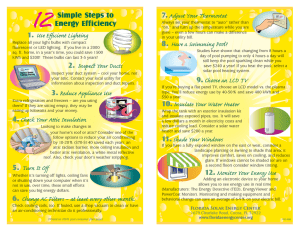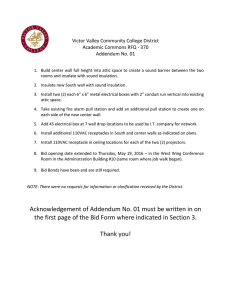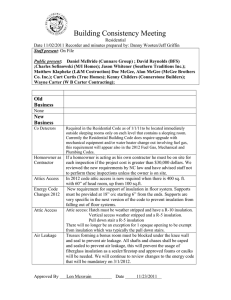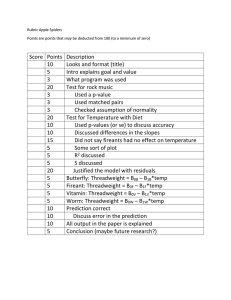SPF Out Performs Fiberglass In Attic Insulation
advertisement
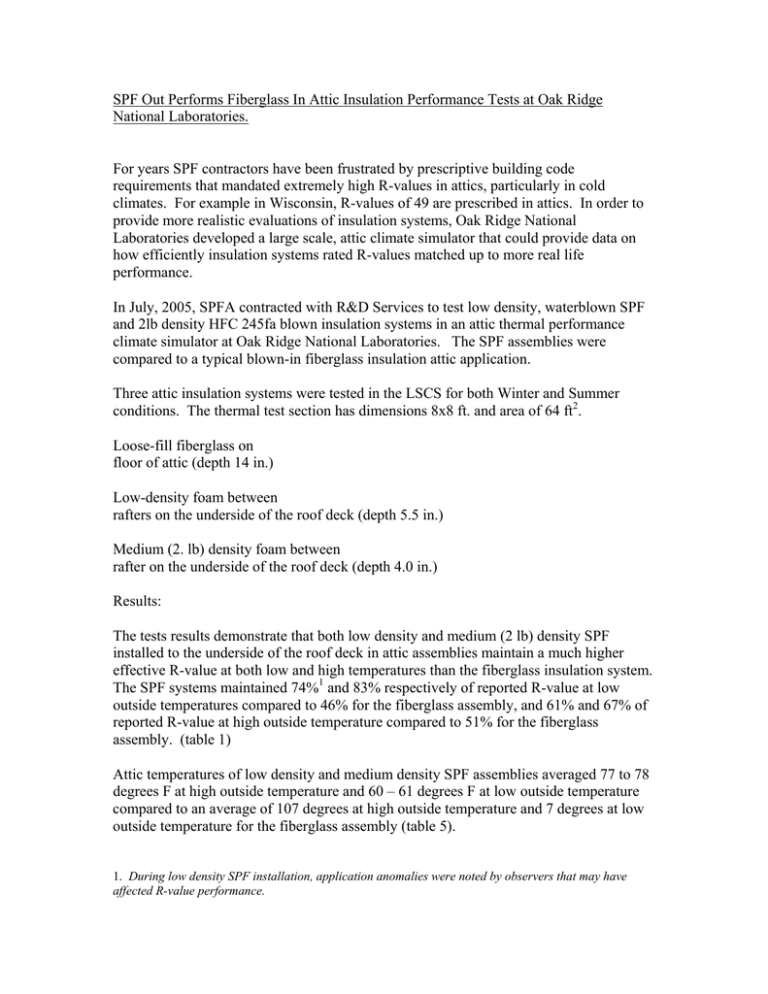
SPF Out Performs Fiberglass In Attic Insulation Performance Tests at Oak Ridge National Laboratories. For years SPF contractors have been frustrated by prescriptive building code requirements that mandated extremely high R-values in attics, particularly in cold climates. For example in Wisconsin, R-values of 49 are prescribed in attics. In order to provide more realistic evaluations of insulation systems, Oak Ridge National Laboratories developed a large scale, attic climate simulator that could provide data on how efficiently insulation systems rated R-values matched up to more real life performance. In July, 2005, SPFA contracted with R&D Services to test low density, waterblown SPF and 2lb density HFC 245fa blown insulation systems in an attic thermal performance climate simulator at Oak Ridge National Laboratories. The SPF assemblies were compared to a typical blown-in fiberglass insulation attic application. Three attic insulation systems were tested in the LSCS for both Winter and Summer conditions. The thermal test section has dimensions 8x8 ft. and area of 64 ft2. Loose-fill fiberglass on floor of attic (depth 14 in.) Low-density foam between rafters on the underside of the roof deck (depth 5.5 in.) Medium (2. lb) density foam between rafter on the underside of the roof deck (depth 4.0 in.) Results: The tests results demonstrate that both low density and medium (2 lb) density SPF installed to the underside of the roof deck in attic assemblies maintain a much higher effective R-value at both low and high temperatures than the fiberglass insulation system. The SPF systems maintained 74%1 and 83% respectively of reported R-value at low outside temperatures compared to 46% for the fiberglass assembly, and 61% and 67% of reported R-value at high outside temperature compared to 51% for the fiberglass assembly. (table 1) Attic temperatures of low density and medium density SPF assemblies averaged 77 to 78 degrees F at high outside temperature and 60 – 61 degrees F at low outside temperature compared to an average of 107 degrees at high outside temperature and 7 degrees at low outside temperature for the fiberglass assembly (table 5). 1. During low density SPF installation, application anomalies were noted by observers that may have affected R-value performance. This statistic is important for buildings that have ducts and HVAC units in attics. The high and low attic temperatures require much more energy to heat & cool and contribute to wider temperature ranges between levels of the building. (Table 2) Table 1 Comparison of Tested R-Values and Labeled R-Values Attic Thermal Testing at Oak Ridge National Laboratory Insulation Blown Fiber Glass @ 14 inches Low-Density SPF @ 5.5 inches High Density SPF @ 4.0 inches Test Number Insulation Labeled RTemperature Value 1a (low temp) 1b (low temp) 1c (avg temp) 1d (high temp) 2a (low temp) 2b (low temp) 2c (avg temp) 2d (high temp) 3a (low temp) 3b (low temp) 3c (avg temp) 3d (high temp) 38.01 38.03 Tested RValue (C 1363) 17.7 % Labeled 47 17.7 47 29.0 76 88.97 20.2 53 32.61 14.7 74 32.73 14.7 74 13.6 69 93.00 12.1 61 32.89 22.8 84 33.01 22.7 83 19.8 73 18.1 67 51.75 48.49 48.79 93.07 38 19.8 27 Table 2 Attic Air Temperatures Observed in ORNL LSCS Project Attic air temperatures were recorded for each of the 12 measurements at locations six inches below the peak of the attic and 12 inches below the peak of the attic. This was done using thermocouples suspended in the attic air space. The temperatures are in ºF. Test No. Interior Temp. 6-inches from peak 12-inches from peak Exterior Temp 1a 1b 1c 1d 69.99 69.98 69.96 70.06 7.75 7.54 32.73 108.14 7.75 7.44 32.72 107.75 0.20 0.09 30.12 109.93 2a 2b 2c 2d 70.02 70.01 69.99 70.03 60.31 60.33 64.04 78.28 60.42 60.47 64.18 77.78 -0.21 0.00 30.15 109.87 3a 3b 3c 3d 70.03 70.02 70.01 69.97 61.39 61.44 64.80 77.10 61.45 61.56 64.90 76.72 0.10 0.23 29.99 109.95
